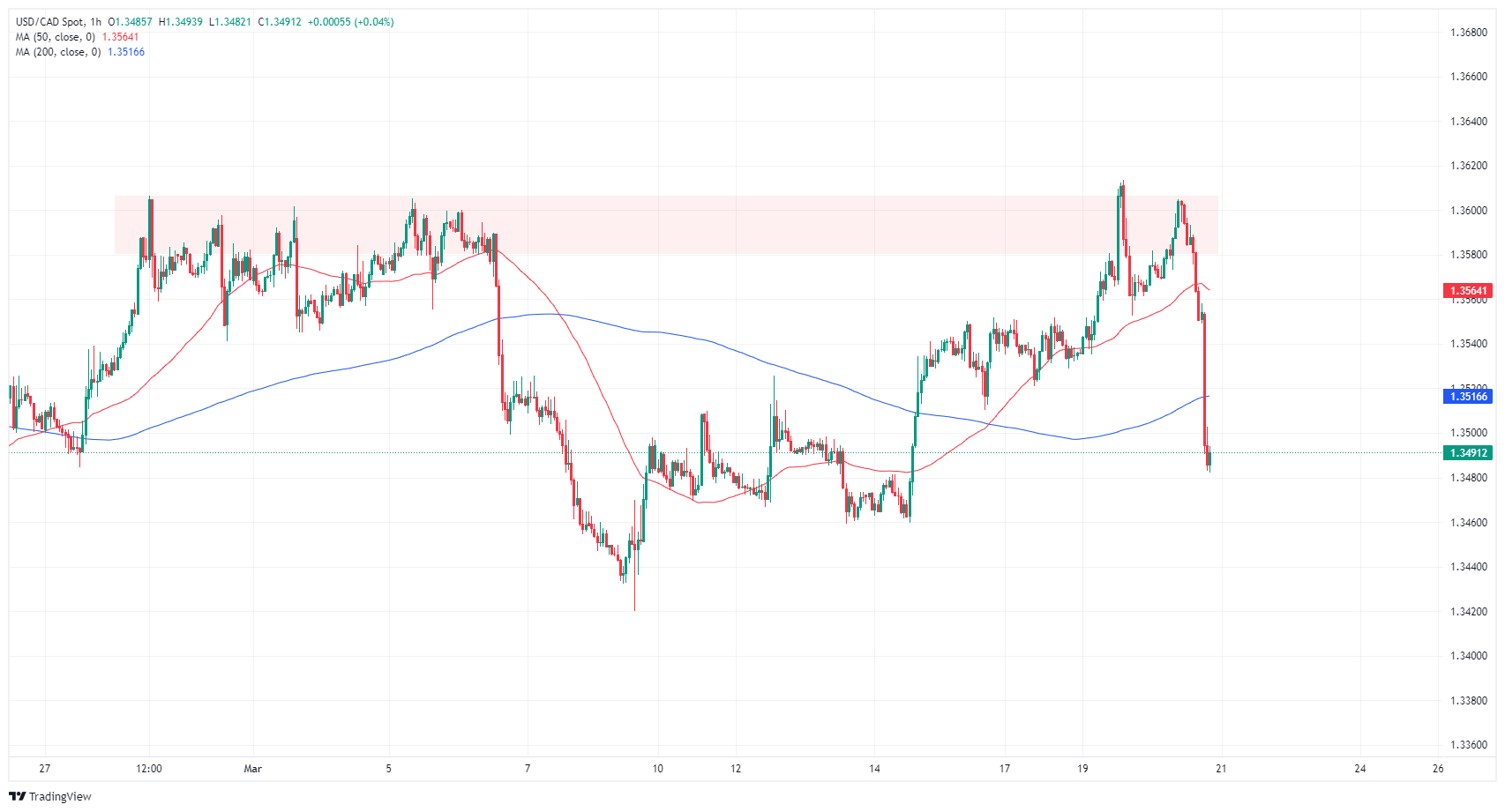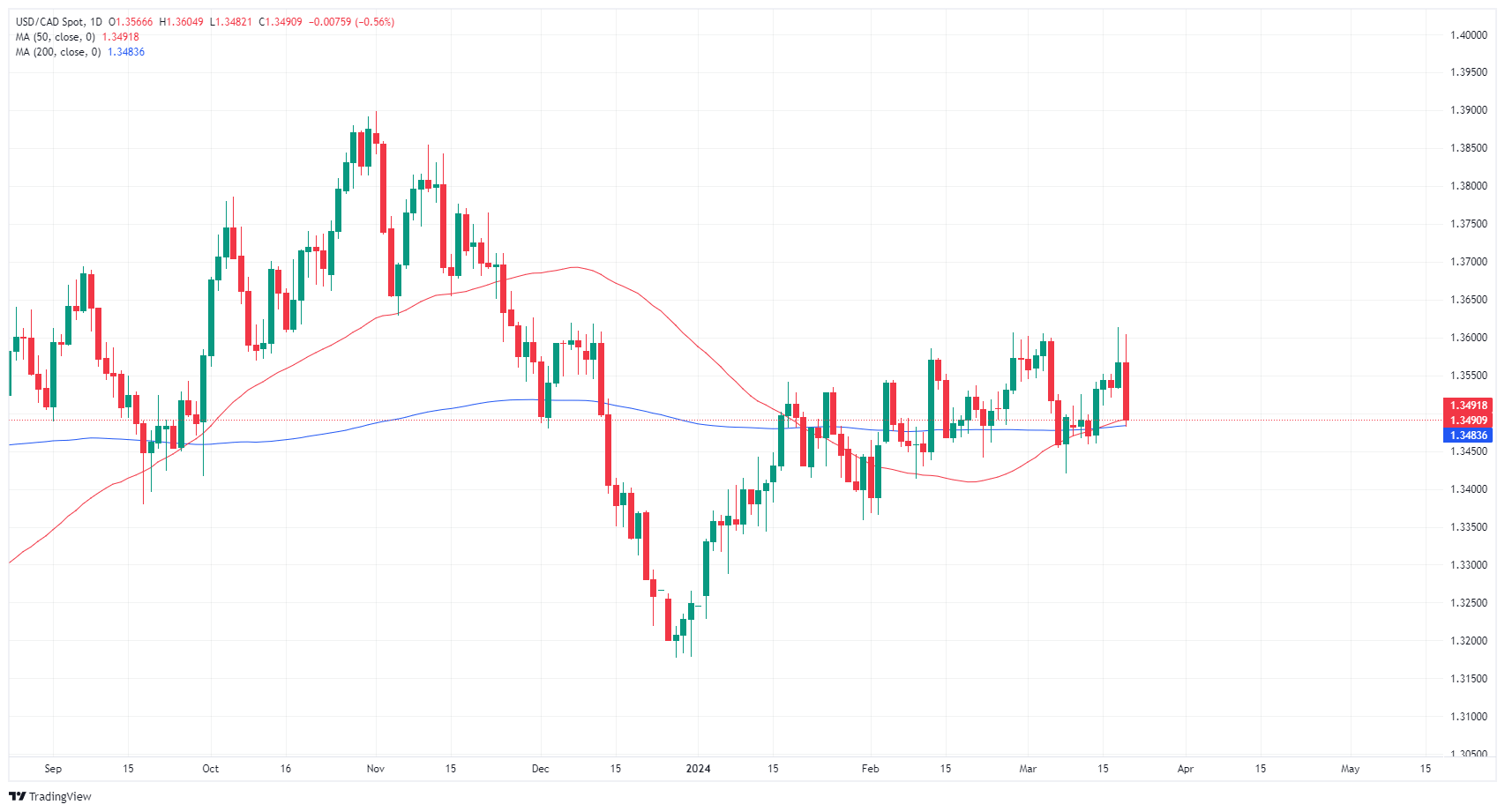Canadian Dollar finds the high end after Fed keeps rates pinned at 5.5%
- The Canadian Dollar is bound in the midrange as investors await FOMC.
- Bank of Canada to get drowned out by market’s Fed rate cut expectations.
- Fed expected to hold, investors hope for a June rate cut.
The Canadian Dollar (CAD) hit a bump and run after the Federal Reserve (Fed) held rates at 5.5%, in-line with broad market expectations. However, investors leaned into the risk-on side despite increases in forecast growth expectations and Fed Chairman Jerome Powell shrugged off several months of missed inflation forecasts.
The Bank of Canada released its latest Summary of Deliberations at 17:30 GMT, just ahead of the Fed’s latest Economic Projections. Little new was revealed in the BoC's minutes from its latest rate meeting. Canadian Consumer Price Index (CPI) inflation cooled this week, with February’s YoY CPI easing to 2.8% from the previous 2.9%, surprising markets that expected an increase to 3.1%. Canadian CPI inflation is easing enough that further rate hikes are unlikely, but not fast or hard enough to spark an immediate rate cut schedule.
Daily digest market movers: Canadian Dollar pushed higher post-Fed
- The US Fed held rates steady at 5.5%, as markets broadly anticipated.
- Investors hoping for hints about rate cuts coming sooner rather than later decided they got what they wanted, and broad-market risk appetite surged despite an uptick in Fed growth forecasts and a slight increase in longer-term forward-looking interest rate forecasts.
- The Fed's Dot Plot of interest rate forecasts now sees one-year interest rates somewhere around 3.9% versus the previous 4.6%.
- Long-term Interest Rate Projections ticked up to 2.6% from the previous 2.5%.
- According to the CME's FedWatch Tool, rate futures markets are now pricing in a 70% chance of a rate cut in June after the Fed's rate call, up slightly from the 65% odds prior to Fed Chairman Jerome Powell's press conference.
- Read more: Jerome Powell speaks on policy outlook after leaving interest rate unchanged
Canadian Dollar price today
The table below shows the percentage change of Canadian Dollar (CAD) against listed major currencies today. Canadian Dollar was the weakest against the Australian Dollar.
| USD | EUR | GBP | CAD | AUD | JPY | NZD | CHF | |
| USD | -0.52% | -0.52% | -0.66% | -0.90% | 0.02% | -0.58% | -0.27% | |
| EUR | 0.51% | 0.00% | -0.14% | -0.37% | 0.53% | -0.04% | 0.25% | |
| GBP | 0.53% | 0.00% | -0.14% | -0.35% | 0.53% | -0.06% | 0.25% | |
| CAD | 0.65% | 0.12% | 0.14% | -0.23% | 0.67% | 0.10% | 0.39% | |
| AUD | 0.86% | 0.35% | 0.35% | 0.22% | 0.90% | 0.33% | 0.61% | |
| JPY | -0.01% | -0.52% | -0.54% | -0.68% | -0.87% | -0.58% | -0.27% | |
| NZD | 0.56% | 0.03% | 0.05% | -0.10% | -0.33% | 0.53% | 0.26% | |
| CHF | 0.25% | -0.26% | -0.26% | -0.40% | -0.62% | 0.28% | -0.31% |
The heat map shows percentage changes of major currencies against each other. The base currency is picked from the left column, while the quote currency is picked from the top row. For example, if you pick the Euro from the left column and move along the horizontal line to the Japanese Yen, the percentage change displayed in the box will represent EUR (base)/JPY (quote).
Technical analysis: Canadian Dollar churns against Greenback after backsliding to 1.3600
The Canadian Dollar (CAD) kicked off Wednesday by stumbling back against the US Dollar (USD), pushing the USD/CAD pair into the 1.3600 handle. The CAD recovered into the day’s opening range, sticking close to 1.3560. Post-Fed, the Canadian Dollar has climbed around two-thirds of a percent against the US Dollar, and the USD/CAD pair has been forced down below the 1.3500 handle. Near-term technical floors are priced in near 1.3460 at last week's low bids.
USD/CAD continues to churn in the same neighborhood as the 200-day SMA at 1.3480, and a rising higher lows pattern remains firmly printed into the charts, but momentum remains low. The pair is broadly stuck in a medium-term range, with bids cycling the midpoint between late December’s swing low into 1.3200 and last November’s peak bids near 1.3900.
USD/CAD hourly chart
USD/CAD daily chart
Canadian Dollar FAQs
The key factors driving the Canadian Dollar (CAD) are the level of interest rates set by the Bank of Canada (BoC), the price of Oil, Canada’s largest export, the health of its economy, inflation and the Trade Balance, which is the difference between the value of Canada’s exports versus its imports. Other factors include market sentiment – whether investors are taking on more risky assets (risk-on) or seeking safe-havens (risk-off) – with risk-on being CAD-positive. As its largest trading partner, the health of the US economy is also a key factor influencing the Canadian Dollar.
The Bank of Canada (BoC) has a significant influence on the Canadian Dollar by setting the level of interest rates that banks can lend to one another. This influences the level of interest rates for everyone. The main goal of the BoC is to maintain inflation at 1-3% by adjusting interest rates up or down. Relatively higher interest rates tend to be positive for the CAD. The Bank of Canada can also use quantitative easing and tightening to influence credit conditions, with the former CAD-negative and the latter CAD-positive.
The price of Oil is a key factor impacting the value of the Canadian Dollar. Petroleum is Canada’s biggest export, so Oil price tends to have an immediate impact on the CAD value. Generally, if Oil price rises CAD also goes up, as aggregate demand for the currency increases. The opposite is the case if the price of Oil falls. Higher Oil prices also tend to result in a greater likelihood of a positive Trade Balance, which is also supportive of the CAD.
While inflation had always traditionally been thought of as a negative factor for a currency since it lowers the value of money, the opposite has actually been the case in modern times with the relaxation of cross-border capital controls. Higher inflation tends to lead central banks to put up interest rates which attracts more capital inflows from global investors seeking a lucrative place to keep their money. This increases demand for the local currency, which in Canada’s case is the Canadian Dollar.
Macroeconomic data releases gauge the health of the economy and can have an impact on the Canadian Dollar. Indicators such as GDP, Manufacturing and Services PMIs, employment, and consumer sentiment surveys can all influence the direction of the CAD. A strong economy is good for the Canadian Dollar. Not only does it attract more foreign investment but it may encourage the Bank of Canada to put up interest rates, leading to a stronger currency. If economic data is weak, however, the CAD is likely to fall.